Heads Of Iran’s Government Branches Meet Over Large Corruption Case
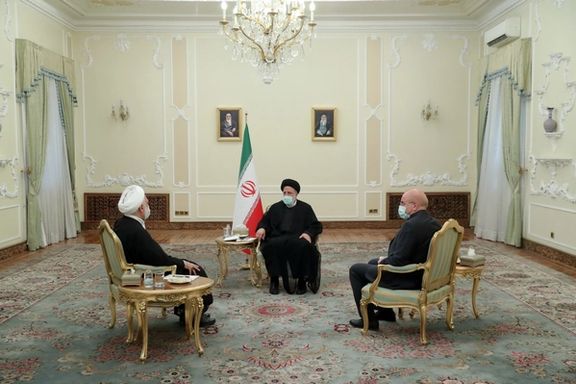
The heads of the three branches of the Iranian government have held a meeting as a major corruption case at Iran's Mobarakeh Steel Plant implicated dozens of state entities.

The heads of the three branches of the Iranian government have held a meeting as a major corruption case at Iran's Mobarakeh Steel Plant implicated dozens of state entities.
Following their meeting on Saturday afternoon, President Ebrahim Raisi, Parliament Speaker Mohammad-Bagher Ghalibaf, and Chief Justice Gholam-Hossein Mohseni-Ejei warned against "media speculations" until the review of the case is completed by the judiciary.
Only the judiciary should review and assess the reports of the parliament’s investigation, and it is necessary to refrain from media speculations until these reports are scrutinized in judicial courts, they announced.
Last week, a scathing report about an alleged $3 billion corruption case revealed massive irregularities and mismanagement in government-controlled Mobarakeh Steel Company, the largest steel producer in the Middle East and Northern Africa, which is located near the city of Mobarakeh, Esfahan Province.
The over 250-page report says the company paid astronomical sums of money to various government entities including the Revolutionary Guard (IRGC), ministry of intelligence, police, state broadcaster (IRIB), Friday prayer imam’s offices, religious seminaries, and bribed others such as certain media outlets, individuals, and social media influencers.
The company, which has a share of around 1% in Iran's GDP, employs around 350,000 people directly and indirectly and feeds over 2,800 other large and small enterprises.
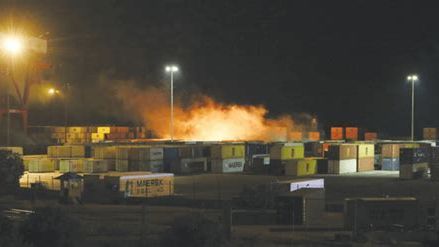
An Israeli airstrike on the western Syrian city of Masyaf on Thursday destroyed more than 1,000 Iranian-made missiles, a Syrian war monitor reported Saturday.
According to the UK-based Syrian Observatory for Human Rights, the attack targeted a missile warehouse in the city’s Syrian Scientific Studies and Research Center (SSRC) complex that stored thousands of medium-range, surface-to-surface missiles assembled under the supervision of Iran’s Revolutionary Guard’s “expert officers.”
The observatory added that 14 Syrian civilians sustained injuries with varying levels of severity during the Masyaf airstrike, in addition to casualties reported among Iranian-backed militias guarding the research center– which is heavily damaged during the attack.
Moreover, several fires broke out in areas surrounding the city ignited by the shrapnel from the explosions of the warehouse, with nearby civilian houses and property suffering material damage, the report said. Secondary explosions continued for hours after the strikes, along with the blazes caused by them. Local residents were reportedly instructed to remain in shelters until the fires were brought under control.
In addition to the strikes attributed to Israel, the United States also engaged in a string of tit-for-tat attacks last week against Iranian militias in northern Syria who had targeted US forces with rockets and drones.
Iran-backed militias established a foothold in Syria while fighting in support of President Bashar al-Assad during Syria's civil war.
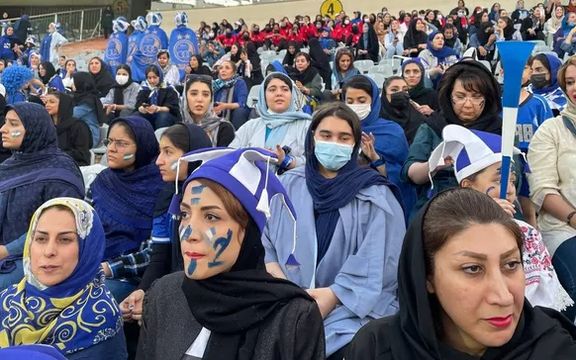
Under pressure from world soccer federation, FIFA,500 female fans were allowed into Tehran's Azadi Stadiumto watch a local league football match.
Tickets were sold only to 500 female fans and a special forces unit consisting of female anti- riot police was present to lead them to their secluded section of the 100,000-seat stadium. many say the ban on women’s presence at soccer matches was only lifted under pressure from the international governing body of association football (FIFA).
The world’s soccer authority had tried to convince Iran’s government to lift an unwritten ban on women attending stadiums to watch male players for nearly a decade.
The ban has led to many arrests, beatings, detentions, and abuses against women.
Iranian officials have always argued that male football fans swear profanities, so the atmosphere of stadiums is not suitable for women even if they are seated in a different part of the stadium.
“I wish you had voluntarily opened stadium gates to Iranian women and FIFA’s pressure wasn't behind the realization of [female fans’] right [to watch games in stadiums],” Azar Mansouri, the first female party leader in Iran wrote in a commentary in reformist Etemad newspaper Sunday.
“Opposingthe demands of half of the country’s population for going to stadiums, cycling in public, and the right to choose how to dress, means the demand to end discrimination. Why should a plea such as going to stadiums be opposed in the name of religion in a society which is susceptible to tension and every kind of protest and violence, so that people say FIFA’s pressure saved Iranian woman,” Mansouri who was elected secretary-general of the Etehad-e Mellat (Nation’s Unity) Party in December wrote.
Ensieh Khazali, Vice President for Women and Family Affairs, however, claimed on Sunday that the decision to allow women’s presence at the game was made by the ministry of sports and pressure from FIFA had no role in it.
Many Iranians had urged FIFA to ban their country from the World Cup after hundreds of female fans were once again denied entry into a soccer stadium on March 1 in Mashhad in northeastern Iran to watch a World Cup qualifier between Iran and Lebanon, despite FIFA’s pressure to lift the ban on women entering stadiums. The fans, with tickets in their hands, were stopped from entering and were pepper-sprayed when they demanded to be allowed in.
Authorities tried to use the unprecedented presence of women at Azadi Stadium on Friday for regime propaganda but videos circulating on social media show enraged fans booing, during a religious and ideological propaganda song performed by a choir during halftime and drowning the choir’s voice.
The song, ‘Hello Commander’, is heavily promoted by the Islamic Republic, especially among children, and was first performed to a full stadium of mobilized regime supporters and school children on May 27.
‘Hello Commander’ is a song dedicated to Mahdi, the 12th Imam of Shiites who has been in occultation since the 9th century according to Shiite believers. The song and its promotion are unusual as the music is in the often frowned upon pop genre which has no place on Iran’s state media.
‘Hello Commander’ also mentions Supreme Leader Ali Khamenei who is believed by his devotees to be the Imam’s representative on earth and has to be obeyed as the Imam would be if he were present among believers.

Iran’s review of the US response regarding the possible revival of the 2015 nuclear deal will continue until Friday, while hardliners have called on Tehran not to accept the agreement.
In a tweet on Sunday, Nour News, a website affiliated with the secretary of Iran's Supreme National Security Council (SNSC), Ali Shamkhani, said that “the precise examination of US's responses to Iran's modified pivots regarding the proposal of the European Union coordinator, is still ongoing at expert levels, and this process will continue at least until the end of this week.”
The Iranian week ends on Friday, September 2.
Meanwhile, Iran's hardline Kayhan Daily, affiliated with Supreme Leader Ali Khamenei’s office, has called on the government to leave the negotiations and proceed without reviving the landmark accord.
“The path taken in these years has proven that with negotiations [Iran] cannot remove the sanctions, and with more negotiations only the scope of [other side’s] the demands will become wider,” the newspaper said.
The article noted that the capabilities of the Iranian government and the regional and global developments have provided the administration of Ebrahim Raisi with a good opportunity to correct the deviated path of the nuclear talks.
Removal of sanctions through negotiations is a bait that the US foreign policy officials have set on the hook, and the government can forget this bait and spend all its focus and energy on neutralizing the effects of the sanctions as it has been doing during the past year, the daily underlined.
Unconfirmed parts of the US response to Iran have been leaked in Tehran, showing Washington’s rejection of three key Iranian demands.
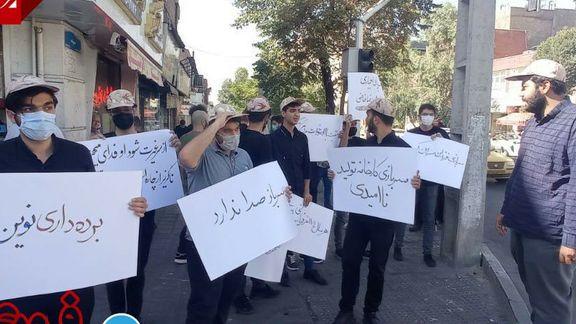
At least one person was arrested on Saturday after security forces attacked protesters to disrupt a gathering against the Islamic Republic’s compulsory military service.
A group of university students held the demonstration in front of Iran’s Public Conscription Organization in downtown Tehran.
They were holding placards bearing slogans against the mandatory service such as "Modern Slavery," "Conscripts have no voice," "Military service: a factory for manufacturing frustration," and "Two years of forced imprisonment.”
Mohammad Eskandari, the secretary of the so-called Student Justice Movement – the NGO which had organized the gathering – was arrested during the crackdown.
Many people are critical of the compulsory nature of the service and its physical and psychological pressures on the conscripts, which in some cases lead to suicide or violent acts.
In March, a young military conscript embarked on a killing spree in one of the barracks in the southern province of Bushehr, killing four of his fellow servicemen after his request for leave was denied.
Earlier in the year, Iran canceled the buy-out scheme for compulsory military service, just one day after it was reported following widespread criticism by citizens and officials. Only wealthy families could afford to buy out their sons military service.
According to Iran’s constitution, all men over 18 years old must serve in the military for about two years, otherwise they cannot apply for a passport to leave the country. Most are drafted into the traditional Army, but some with the right connections serve with the Revolutionary Guard where conditions are much better.
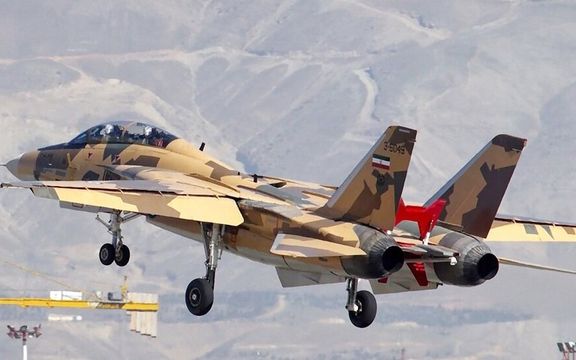
Fars news agency affiliated with Iran’s Revolutionary Guard has showcased an American article about how well Iranian pilots used the F-14 Tomcat fighters.
The article published by a US-based website 19FortyFive re-told the story that the first air-to-air kill by an F-14 was not accomplished by American pilots, but by an Iranian on September 7, 1980, one day after the long Iran-Iraq war began that lasted eight years.
Fars tells its readers that an American website has given credit to pilots of the Islamic Republic for the first air-to-air F-14 victory, one year before US pilots shot down Libyan planes in a punitive engagement. Fars said that the American publication recognized the unique abilities of Iranian pilots with the heavy American fighter designed to face Soviet bombers at long distances.
What Fars does not say is that these fighter pilots who engaged the Iraqi air force one year after the 1979 revolution and the establishment of the Islamic Republic were in fact officers recruited by the Imperial air force during the monarchy and trained by the US Air Force.
It also does not mention how Iran’s last king, Mohammad Reza Shah had been able to get 70 Grumman F-14 Tomcats, a fourth-generation sophisticated fighter, in the 1970s from the United States. In fact, it was President Richard Nixon who approved the sale to one of the most trusted US allies outside NATO at a time when the United States was losing the war in Vietnam and the power and influence of the Soviet Union was on ascendancy.

The Shah’s son, Reza Pahlavi was also sent to the United States to be trained on the F-14 right before revolution broke out. He currently lives near Washington DC and is an influential political figure for many Iranians opposed to the Islamic Republic.
“On September 7, 1980, five Mil Mi-25 (export model of the Soviet Mi-24) attack helicopters in Iraq’s Army Air Corps penetrated Iranian airspace and attacked a few border posts. In response, two F-14 Tomcat pilots intervened in an attempt to take out the aircraft,” the article in 19FortyFive says.
Citing another source, The Aviation Geek, the article explains that the Tomcat pilot failed to hit the MI-25 helicopters with his AIM9P Sidewinder missiles, but “Selecting ‘GUN’ on his control column, he put the gunsight pipper over the rearmost Mi-25 and opened fire. The aircraft’s M61A1 Vulcan gun gull spewed out 400 rounds. Many found their mark and the Iraqi attack helicopter exploded in a brilliant ball of fire.”
There are still around 40 F-14s in the Islamic Republic’s air force that have been somehow maintained, although periodically some have crashed. One Tomcat crashed in June and another in 2019. Some have been used for parts to maintain the others, since the United States severed relations with Iran in 1980 and imposed sanctions on export of US technology to the country.
Iran has also tried to build parts for the Tomcats and adapt homegrown Russian-model air-to-air missiles, but it there is no independent confirmation of their effectiveness.
Still, after nearly 50 years, the F-14 Tomcats are an important part of Iran’s air force, which has a hodgepodge of old Russian, Chinese and even French warplanes that Iraq sent to Iran faced with an imminent US attack.